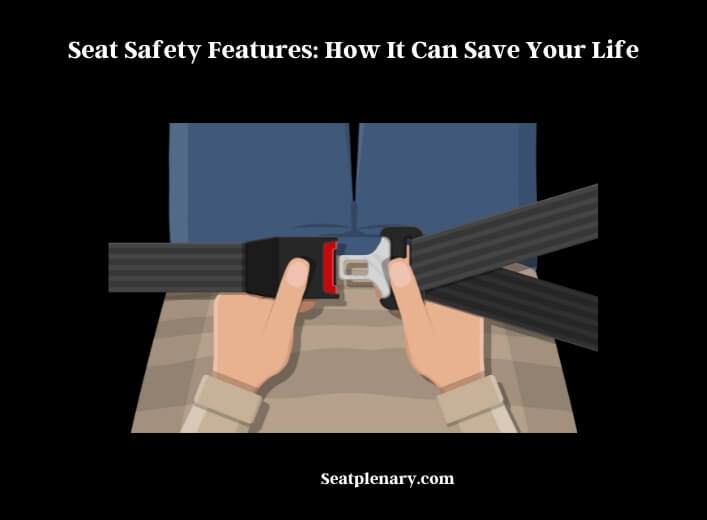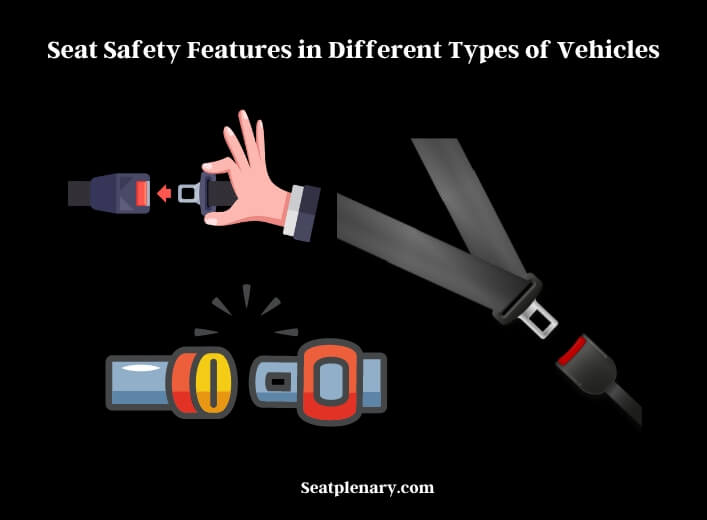When it comes to road safety, many people think of airbags and seatbelts as the most essential safety features in a vehicle. And they are not wrong. Seat safety features are designed to protect drivers and passengers during an accident or collision. Without these safety features, the chances of serious injury or even death increase significantly.

Many drivers and passengers may not be aware of the different types of seat safety features available in vehicles today. As technology advances, so do the safety features designed to protect us on the road. From seatbelts to airbags to collision avoidance systems, there are many safety features available that can help prevent or minimize injuries in the event of an accident.
Types of Seat Safety Features
Seatbelts
Seatbelts are the most basic and essential safety features in any vehicle. They are designed to prevent occupants from being ejected from the vehicle in the event of a collision. There are two types of seatbelts: lap belts and shoulder belts. Lap belts wrap around the waist, while shoulder belts are placed diagonally across the chest and shoulder. Both types of seatbelts work together to keep occupants in place during an accident, reducing the risk of serious injury.
It is important to note that seatbelts only work if they are worn correctly. In the event of a collision, the force of impact can cause serious injury or death if the seatbelt is not properly worn.
Airbags
Airbags are designed to deploy in the event of a collision, providing an extra layer of protection for the occupants. There are several types of airbags, including front airbags, side airbags, and curtain airbags. Front airbags deploy from the steering wheel and dashboard to protect the driver and front passenger’s head and chest. Side airbags deploy from the seat or door, providing protection in the event of a side collision. Curtain airbags are located on the roof and deployed to protect the occupants’ heads during a rollover or side impact.
Headrests
Headrests are often overlooked as a safety feature, but they play an important role in protecting occupants from whiplash injuries. Whiplash occurs when the head suddenly jerks forward and then back, causing injury to the neck and spine. Headrests are designed to prevent this by supporting the head and preventing it from jerking backward during a collision.
There are two types of headrests: fixed and adjustable. Fixed headrests are attached to the seat and cannot be adjusted, while adjustable headrests can be moved up or down to suit the occupant’s height.
Advancements in Seat Safety Features
As technology continues to advance, so do the safety features designed to protect occupants in a vehicle.
Rear-View Cameras
Rear-view cameras are becoming more common in vehicles, and for good reason. These cameras are mounted on the back of the vehicle and provide a view of the area behind the car. This helps the driver to see obstacles and pedestrians that may be in their blind spot. Rear-view cameras can also be useful for parallel parking or backing up in tight spaces.
Collision Avoidance Systems
Collision avoidance systems are designed to help drivers avoid collisions with other vehicles, pedestrians, or obstacles on the road. These systems use sensors, cameras, and radar to detect potential collisions and provide warning signals to the driver. Some collision avoidance systems can even apply the brakes automatically to prevent a collision.
These systems can be particularly useful in preventing rear-end collisions, which are some of the most common types of accidents on the road. By providing early warning signals, collision avoidance systems can give the driver enough time to take evasive action and avoid a collision.
Lane Departure Warning
Lane departure warning systems use cameras or sensors to monitor the vehicle’s position within its lane. If the vehicle starts to drift out of its lane, the system provides an alert to the driver. This can be especially helpful for drivers who may become drowsy or distracted, as it can help prevent accidents caused by drifting out of the lane.
Adaptive Headlights
Adaptive headlights adjust their brightness and direction in response to the vehicle’s speed and steering angle. This helps to improve visibility while driving at night or in poor weather conditions, reducing the risk of accidents caused by poor visibility.
Automatic Emergency Braking
Automatic emergency braking systems use sensors and cameras to detect potential collisions and apply the brakes automatically to prevent a collision. This can be particularly useful in preventing collisions caused by distracted driving or sudden changes in traffic conditions.
Seat Safety Features in Different Types of Vehicles
Seat safety features can vary depending on the type of vehicle. Here are some examples of seat safety features in different types of vehicles:

Cars
Cars typically have a range of seat safety features, including seatbelts, airbags, headrests, and collision avoidance systems. Some newer cars also come equipped with rear-view cameras and lane departure warning systems.
Trucks
Trucks often have additional safety features to accommodate their larger size and weight. These features may include reinforced frames, larger brakes, and stability control systems. Many trucks also come equipped with rear-view cameras and blind spot monitoring systems to help drivers see potential hazards.
SUVs
SUVs are known for their size and ability to handle off-road terrain, but they also come equipped with a range of safety features. These may include seatbelts, airbags, headrests, and collision avoidance systems. SUVs may also have advanced four-wheel-drive systems, which can improve traction and stability in challenging driving conditions.
Vans
Vans are often used for transporting large groups of people, so they typically have additional safety features to protect passengers. These may include side-impact airbags, curtain airbags, and reinforced roofs to protect against rollover accidents. Many vans also have backup cameras and blind spot monitoring systems to help drivers see potential hazards.
Maintaining Seat Safety Features
While seat safety features are designed to protect occupants in the event of an accident or collision, they require proper maintenance and upkeep to ensure that they are functioning properly. Here are some tips for maintaining seat safety features:
Regular Maintenance
It is important to schedule regular maintenance for your vehicle to ensure that all safety features are functioning properly. This includes checking airbags, seatbelts, and other safety systems to make sure that they are not damaged or worn out.
Replace Damaged Components
If any safety components are damaged, it is important to replace them immediately. This includes cracked or broken seatbelts, airbags that have been deployed, and damaged headrests. Do not attempt to repair these components yourself, as improper repairs can compromise their effectiveness in an accident.
Use Safety Features Properly
It is important to use all safety features properly to ensure maximum protection. This includes wearing seatbelts, adjusting headrests to the appropriate height, and using child safety seats correctly. Improper use of safety features can reduce their effectiveness in the event of an accident or collision.
Stay Up to Date With Recalls
Manufacturers may issue recalls for safety components that are found to be defective. It is important to stay up to date with any recalls that may affect your vehicle and to have the necessary repairs performed promptly.
Seek Professional Help
If you are unsure about the maintenance or repair of any safety components, seek professional help. A trained mechanic can help identify and repair any issues with your vehicle’s safety features.
Benefits of Seat Safety Features
Seat safety features can provide numerous benefits for both drivers and passengers.
Preventing injuries: Seat safety features, such as seat belts, airbags, and headrests, are designed to prevent or minimize injuries in the event of an accident. They can help prevent serious head, neck, and spine injuries, as well as internal injuries caused by blunt force trauma.
Reducing fatalities: The use of seat belts and other seat safety features has been proven to reduce fatalities in car accidents. In fact, the National Highway Traffic Safety Administration (NHTSA) estimates that seat belts saved over 14,000 lives in 2016 alone.
Improving vehicle control: Some seat safety features, such as adjustable lumbar support and adjustable headrests, can improve vehicle control and handling. This can lead to a more comfortable and safer driving experience.
Enhancing comfort: Modern seat safety features can also enhance comfort, reducing driver and passenger fatigue during long trips. Features such as adjustable seats and lumbar support can help prevent back pain and stiffness.
Increasing resale value: Cars with advanced seat safety features can often command a higher resale value than those without. This is because many buyers are willing to pay a premium for the added safety and comfort features.
Summary
Seat safety features have come a long way in recent years, with advancements in technology and engineering helping to make driving safer for everyone on the road. From basic seatbelts and airbags to advanced collision avoidance systems and lane departure warnings, seat safety features are designed to protect occupants in the event of an accident or collision.
While seat safety features can help prevent accidents, it is still the responsibility of the driver to remain alert and focused on the road. Proper maintenance and upkeep of these safety features is also crucial to ensure that they are functioning properly in the event of an accident or collision.
When purchasing a vehicle, it is important to research the safety features available and to choose a vehicle that provides maximum protection for you and your passengers. By staying up to date with maintenance and repairs, using safety features properly, and seeking professional help when needed, you can help ensure that you and your loved ones are protected on the road.
